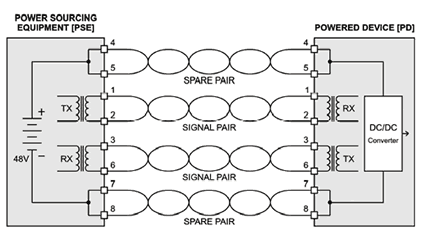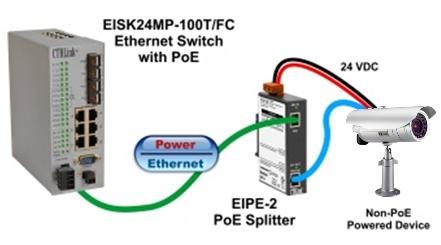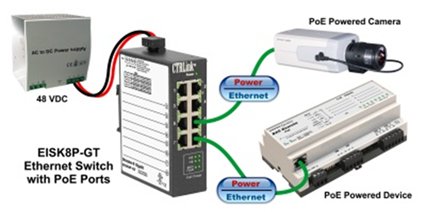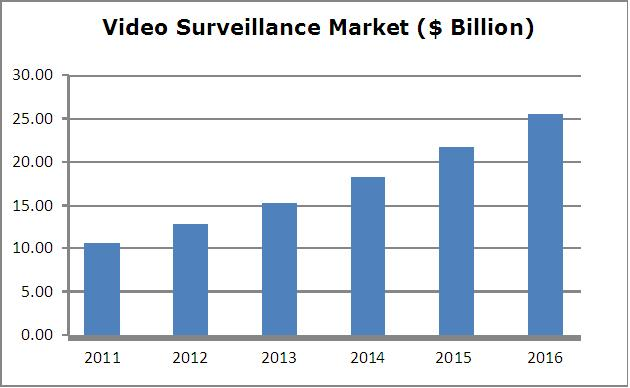|
July 2014
Article
AutomatedBuildings.com
|
[an error occurred while processing this directive]
(Click
Message to Learn More)
|
|
IP Technology Fuels Growth of Video
Surveillance Market
One of the many benefits of IP video surveillance
technology, compared with traditional analog video equipment, is that
digital video is compressed and ran across standard Ethernet networks
using IP which is the same protocol used in corporate networks and the
internet.
|

Kirk Clousson
Product Marketing Manager
Contemporary
Controls
|
Market Shifts
One
of the biggest advances in surveillance is the accelerating shift to
Internet Protocol (IP) from analog. The power and accessibility
of the Internet means that the convergence of IP video surveillance
along with the IP infrastructure is perfect together for accelerated
growth. The shift from analog to digital technology has created
opportunities for a new way of thinking of how security systems are
installed. One of the many benefits of IP video surveillance
technology, compared with traditional analog video equipment, is that
digital video is compressed and ran across standard Ethernet networks
using IP which is the same protocol used in corporate networks and the
internet. Also, there are many ways to design and secure an IP
network. An IP network can be as small or as extensive as your
requirements demand and it can be wired, wireless or a combination of
both. An IP network video surveillance system can grow with a
user’s needs—one camera at a time, while analog systems can often only
grow in steps of four or 16 at a time. IP-based systems provide a
means for network video products and other types of applications to
share the same wired or wireless network for communicating data. Data
can be carried over the same cable and any number of network video
products can be added to the system without significant or costly
changes to the network infrastructure. In addition, it is possible for
wired IP networks to not only deliver data, but they can also be
powered by using Power over Ethernet (PoE) technology. Digital
video can be
transmitted across any broadband network connection, i.e. cable, fiber
or wireless. You can add as many network video products to the
system, as desired, without significant or costly changes to the IP
network infrastructure. You can place, and network, the products from
virtually any location, and the system can be as open or as closed as
you wish.
Modern IP Cameras
During
the last few years, the rapid growth of digital technology has produced
sophisticated cameras, which can directly record high-definition
digital videos. Modern IP surveillance cameras provide up to 16 times
the resolution of traditional analog cameras. The resolution of
IP cameras is many times higher (currently up to 5 megapixels) and can
capture a clearer image when objects are moving. They also cover
larger areas, and offer superior digital zoom capabilities. In fact,
today’s IP network cameras give rich enough detail that you can read
the numbers on a license plate or the name on an ID badge.
Technical advances for these cameras will continue to get better as
time goes on. Adopting the digital revolution from the camera to
the head-end and encoding the video into IP packets directly in the
camera presents numerous advantages. In fact, the system designer
can leverage existing networks and infrastructures irrespective of the
specific medium used to convey the video (e.g., copper, fiber-optic,
etc.). Please note: analog cameras should not be ruled out from
the market as the companies who currently manufacture analog cameras do
not remain idle and continue to progress. Analog camera technology is a
sound solution.
Power over Ethernet ― Ideal Product
Technology
Power
over Ethernet (PoE) technology is ideal for IP surveillance
systems. IP data is communicated over the Internet via a
packet-switched internet using the Internet Protocol Suite, also
referred to as TCP/IP. It enables TCP/IP network devices to
receive power from a PoE enabled switch through the same standard cable
that transmits IP data. PoE equipment adds power to the data in
Ethernet wiring so that devices such as IP video surveillance and card
access machines can be powered via standard Ethernet cabling, whereas
analog needs its own separate wire besides a power wire. PoE keeps the
cabling secure, does not interfere with the network operation, and
reduces installation and maintenance costs. It is widely accepted
and used to power wireless access points and network cameras in a Local
Area Network (LAN).
Often there are places where traditional power wiring for AC power is
not available or easy to install. PoE can bring IP Video
Surveillance to areas where it might not have been applicable and or
cost-effective; depending on the camera location, it can have the
potential to save up to a several hundred dollars per
camera. Using PoE makes it easier to move a camera to a new
location, or add cameras to the video surveillance system without tied
to an electrical outlet, and devices such as IP cameras and wireless
access points can be located wherever they are needed most, and can be
easily repositioned. PoE is also extremely reliable, intelligent, and
designed to protect network equipment from overload, under powering, or
wrong installation thus resulting in a more secure video system.
Using PoE, a video surveillance system can be powered from the server
room, which is often backed up with an uninterruptible power supply
meaning that the video surveillance system can be operational even
during a power outage. Using PoE+, Standard IEEE 802.3at,
doubles the device power. PoE
Technology
As mentioned, PoE technology provides power to Ethernet devices that
have no immediate source of power. It does this by placing 48 VDC
onto the otherwise unused pairs of your CAT5 or higher cable. PoE
applications typically involve two devices such as an IP video camera
and card access systems. For example, an IP video camera and a
card reader is called the powered device (PD). The equipment that
supplies the power is called the power sourcing equipment (PSE).
Your PD can consume up to 13 W — even if installed 100 meters from the
PSE. There are two ways of connecting power as shown in Figures 1
and 2. The first method, Alternative A, (Fig.1) is via the data lines
while the second method, Alternative B, (Fig.2) is via the unused
pairs. 1

Fig.1 - Alternative A. The signal pairs carry both data and power.
Polarity is indeterminate.

Fig.2
-
Alternative B. The unused pairs carry power. Polarity is as shown.
If only one PoE device needs to be powered, an injector can be used. An
injector is inserted mid-span between a standard Ethernet switch and
Ethernet powered device (PD). Power to the injector can be either
24 VAC or VDC. The injector develops the required 48 VDC and
injects the voltage into the Ethernet cable in order to provide power
and data to the powered device. Under certain circumstances, a
non-PoE compliant device can be made compliant with the use of a
splitter. (Fig. 3) If the end device is 10/100 Mbps
Ethernet-based but requires 24 VDC to operate, the splitter will accept
combined power and data connections from a PoE-compliant power sourcing
equipment (PSE) and uses the 48 VDC to generate 24 VDC to power the end
device while passing the data signals. PoE
Injectors and Splitters

Fig. 3 - Non-PoE Compliant Device with Splitter

Fig.
4 – EISK8P-GT Ethernet
Switch w/ PoE Compliant Device
If you’re using multiple PoE port applications, an Ethernet switch
equipped with PoE sourcing ports is required. An end-point PSE such as
the EIDX24MP-100T EIDX Managed Switches or EISK8P-GT
EISK8P-GT-GigE
Switch can drive a mid-span splitter or a PoE
compliant powered device directly. (Fig. 4) Power for the PoE switch
originates from an isolated 48 VDC power supply. For larger
systems requiring from four to eight points of PoE, there are Ethernet
switches available to provide the maximum 13 W of power to each PD.
These switches require 48 VDC input power.
Industrial Ethernet Products
Industrial Ethernet products provide ruggedness with temperature rings,
scalability and fiber cabling, which is why the emergence of industrial
grade Ethernet is the equipment of choice for IP video
surveillance. When building your IP infrastructure you need to
take into account that not all Ethernet switches are equal. IP video
surveillance requires hardened networking products that are reliable,
due to heavy demands placed on them. Surveillance video operates
24/7 and depending on the application may need to meet extreme
temperature demands. While choosing office grade products may be
attractive because of their initial low cost appeal, this may be a
major false economy resulting in costs accrued from site visits and
compensation for system downtime. Industrial grade Ethernet products
are inherently more dependable with higher Mean Time between Failures
(MTBFs).2 You don’t want a switch to fail in a surveillance
application, or any application for that matter, but particularly when
security is at stake. With companies putting more network
traffic and applications such as IP cameras on their Ethernet
infrastructure, the results are greater demand on networks.
Wireless
Wireless Local Area Network (WLAN) provides a practical solution
beginning with eliminating the need to run cable between a LAN and a
network camera. Bandwidth capacity of the wireless access point and the
bandwidth requirements of the network devices should be considered when
setting up a wireless network. Typically, the useful data throughput
supported by a particular WLAN standard is about half the bit rate
stipulated by a standard due to signaling and protocol overhead. With
network cameras that support 802.11g, no more than four to five of such
cameras should be connected to a wireless access point.
As
far as the IP video surveillance system, the wireless interface is
transparent and is simply a replacement or extension of the standard
wired IP network meaning connecting to a wireless network is the same
as connecting to an Ethernet switch. For security purposes,
encryption is built into the technology. A wireless IP router such as
the EIPR series router offers a good solution EIPR
Series Routers. IP
routing is economical, provides optimal routing, and is resilient. IP
wireless routing is convenient in situations where there is a need to
move cameras to new locations on a regular basis.
More Key Technologies
Virtual Local
Area Network (VLAN) is a unique, broadcast domain created
by managed Ethernet switches, which uses the switch to partition a
physical network, in turn creating distinct broadcast domains. A
VLAN has the same qualities as LAN but it allows end stations to be
grouped together even if they are not on the same network switch. VLAN
membership can be configured through software instead of physically
relocating devices or connections. Without VLANs, a switch
considers all interfaces on the switch to be in the same broadcast
domain. VLANs allow more control in implementing security policies and
used to overlay IP video surveillance traffic on an existing data
networks. By assigning the IP surveillance traffic to a separate,
distinct, high-priority VLAN, the traffic is assured to pass through
the network quick and secure. Besides network segmentation, VLANs
offer several key benefits including security and bandwidth
availability. Because surveillance data can be sensitive, network
administrators don’t want it accessible across the entire network. Only
authorized users physically connected to the network will have access
to video surveillance traffic, and unwanted users will be kept
out. This is especially useful when an IP surveillance network
shares the same network infrastructure with other functions or
applications, such as a corporate data network. As for bandwidth
availability, a dedicated network ensures bandwidth will always be
reserved for the surveillance traffic, as needed. Often security
integrators are often not aware that these same security and bandwidth
requirements can be realized on one common network by using VLAN
technology.
Quality of
Service (QoS) refers to a network’s ability to achieve
maximum bandwidth and deal with other network performance elements like
latency, error rate and uptime. It helps provide higher quality network
performance for critical applications and predictable throughput for IP
video, as well as minimizes traffic delay, and jitter. QoS is a
key element with managing network congestion during periods where
bandwidth is constrained. QoS capabilities in network switches
allow data prioritization so that time-sensitive and system-critical
data can be transferred smoothly with minimal delay over a
network. For example, a required bit rate or delay measurement
may be guaranteed, making QoS important if the network capacity is
potentially insufficient, especially for real-time, streaming, and
multimedia applications such as IP video, VoIP, streaming media,
videoconferencing and online gaming. Without QoS, if a corporate
data network experiences a heavy traffic event caused by mass file
transfers, broadcast storms or other such applications, the
surveillance video may freeze skip or even drop out completely.
For mission-critical video surveillance, this risk is unacceptable.
Network
redundancy is essential for IP surveillance. Redundancy
technology helps to ensure a reliable and continuous IP network for
mission-critical video transmissions. Since any single network link
carries multiple video streams, a link failure can result in serious
loss of video streams. In fact, a single link failure can result
in serious loss of images, which is not acceptable for a surveillance
system.
[an error occurred while processing this directive]Noticeable Trends
Mobility is reshaping the IP video surveillance market. With
mobility,
users on mobile devices can review surveillance footage in real time,
significantly increasing the opportunity for monitoring situations.
There is also the trend for mobile devices to transmit footage in real
time back to a control center providing assessments of emergencies.
This allows for greater security especially with large crowds, or any
type of high-profile event.
Cloud-based
video surveillance also known as Video Surveillance as a
Service (VSaaS) is valued at over $500+ million and growing.3
With network bandwidth improving along with network product pricing
declining, cloud based video surveillance solutions are drawing the
attention of more suppliers.
Convergence of
teams has resulted from the move to IP video
surveillance because it demands the attention of IT departments along
with additional experts. More IT professionals are asked to work with
integrators and their own security departments to leverage the robust
security applications IP offers. Implementing successful IP video
implementations means that IT is required into the mix early, so the
department can anticipate any issues that may develop.
IP Network Benefits
- Open
Standards: An open network protocol enables
the guarantee of choosing a variety of products from various
manufacturers. Network video products based on open standards can be
easily integrated with computer and Ethernet based audio and security
systems, video management and application software, and other digital
devices. You are not forced to use a particular system or platform. You
have the ability to integrate with other Ethernet and security
equipment making your video surveillance system future
proof.
- Scalability/flexibility:
An IP video surveillance
system can grow with your needs. You can add as many network video
products to the system as desired, without significant or costly
changes to the network infrastructure. You can place and network the
products from virtually any location.
- Cost-effectiveness:
An IP Video Surveillance system
has a lower Total Cost of Ownership (TCO) than traditional analog CCTV
surveillance. Management and equipment costs are lower since backend
applications and storage run on industry standard, open systems based
servers and not on proprietary hardware such as a DVR in the case of an
analog CCTV system. Cost savings also come from the infrastructure
used. IP-based video streams can be routed globally using a variety of
interoperable infrastructure. IP based networks such as LANs and the
Internet, and various connection methods such as wireless are much less
expensive and an IP infrastructure can be leveraged for other
applications across the company. Lastly, savings can be achieved from
PoE technology, which cannot be applied to an analog video system.
- Reliability:
Reliability is a key benefit of IP
networks as they integrate many features that prevent data loss, back
up mission-critical data, and recover quickly from outages. A network
management system can monitor all networked devices: cameras, switches,
access points, and storage, and generate notifications if issues arise.
For instance, if an IP camera goes offline, a network management system
can immediately alert administrators, who can then reassign another
camera to cover that area, no matter where the administrators are.
Typically, the back-up storage can automatically take over and no
recorded data is lost.
- Availability:
IP network cameras can by deployed
anywhere reachable by Ethernet cabling or a wireless access point,
expanding deployment options to include longer reaches or even outdoor
coverage. PoE, which is not available in analog video systems,
simplifies installation of network cameras/video encoders.
- Improved
video quality: With digital, pixel image
sampling an entire image is captured at one time. This ensures sharp
images even with a high degree of motion.
- Remote
accessibility: Authorized users can access
real-time video at any time from any authorized computer anywhere.
Remote accessibility provides an easy way to capture and distribute
high quality video over any kind of IP network or the Internet. The
video can be stored at remote locations for convenience and security,
and the information can be transported over the LAN or Internet.
- Easy
installation: IP surveillance systems are
typically fast and easy to install. Contemporary Controls products
offer PoE support, simplifying installation since only one cable is
needed for power and video. The products are out-of-the-box
outdoor-ready further speeding up installation, even in the toughest of
conditions.
Market Growth
MarketsandMarkets predicts the total video
surveillance applications market to reach $25.43 billion by 2016 at a
CAGR of 19.35% from 2011 to 2016. The IP video surveillance market
currently is estimated to be $5.15 billion in 2011 and is expected to
reach $15.89 billion at an estimated CAGR of 25.31% from 2011 to 2016.
As of 2011, the analog video surveillance market is estimated to be
$5.36 billion and is expected to grow with CAGR of 12.24% to reach
$9.54 billion by the end of 2016.4

Fig. 5 – Video Surveillance Market 2011 – 2016 by MarketsandMarkets
Market Segments
Video surveillance systems have made progress into an abundance of
application sectors such as commercial, infrastructure, institutions,
industrial and residential. With the advent of globalization,
businesses have expanded and spread to overseas locations. Therefore,
surveillance systems are now also being used for real-time and remote
supervision and IP video surveillance has become a mandatory
requirement across many sectors.
- Industries and governments use IP video
surveillance to support their operations.
- Governments depend heavily on IP video
surveillance
as an integral part of crime prevention and homeland security measures.
- Energy companies and utilities use IP
video
surveillance to monitor the condition of remote equipment and to ensure
the physical security of their critical assets.
- Transportation including mass transit,
highways and
airports depend on video surveillance to safeguard critical assets from
possible terrorist attacks and for day-to-day traffic monitoring to
ensure passenger safety. Seaports and freight companies use video
surveillance for theft prevention.
- Retailers rely on video surveillance to
identify
suspicious and illegal behavior that takes place in product aisles and
at the POS. It is estimated that retailers in North America
experience some $45 billion in retail shrinkage annually to employee
theft, shoplifting and organized criminal efforts.5
Besides
independent retailers, you also have the facility management companies
that manage shopping malls who utilize very sophisticated video
surveillance systems.
- Education ― K-12 and universities are
unfortunately
widely considered one of the fastest growing market segments. Since
Sandy Hook in December 2012, school shootings continue in the US at
alarming rates.
- Additional markets segments include
manufacturing
facilities, financial institutions, lodging/entertainment, healthcare,
commercial office buildings, and residential.
Something To Think About
Increasing security concerns and the recent rash of terrorist
activities have forced governments around the world to invest in video
surveillance technologies for homeland security. This has significantly
boosted the growth of the global video surveillance market. Video
surveillance is now migrating towards computer networks, transmitting
video by IP protocol. In the U.S., in some of the developed states like
New Jersey, it is nearly impossible to travel and not be observed on
cameras. In the United Kingdom, there is a video surveillance camera
for every 14 people. People in London are caught on surveillance
cameras up to 300 times a day.6 IP video surveillance is
growing and
for good reason. Protecting our greatest asset is something you cannot
put a price on.
References:
1. Industrial Ethernet Book - Issue 27
http://www.iebmedia.com/index.php?id=4749&parentid=63&themeid=255&hft=27&showdetail=true&bb=1&PHPSESSID=1vi17e5norog6lgjht3hb3r3v1
2. Amplicon
http://www.amplicon.com/security/ip.cfm
3. Cameramanager.com
http://www.cameramanager.com/files/Video%20Surveillance%20Industry%20-%20Market%20size.pdf
4. MarketsandMarkets
www.marketsandmarkets.com
5. Security Executive Council
https://www.securityexecutivecouncil.com/newsroom/strategic_news.html
6. The Independent
http://www.independent.co.uk/news/uk/this-britain/how-average-briton-is-caught-on-camera-300-times-a-day-572781.html
About the Author
Kirk Clousson is the Product Marketing Manager for Contemporary
Controls. Kirk directs the Company’s marketing communications
initiatives and is involved in product marketing, and strategic
marketing. Prior joining Contemporary Controls Kirk was the District
Marketing Leader for Trane where he led the marketing efforts for 15
years.
Contemporary Controls will reach its 40th anniversary is in 2015. The
Company designs and manufactures network communications products for
the global marketplace and has locations around the world, a reputation
for technical support, and the expertise required to make building
automation projects successful. For more information, visit
www.ccontrols.com,
call 630-963-7070 or email info@ccontrols.com
footer
[an error occurred while processing this directive]
[Click Banner To Learn More]
[Home Page] [The
Automator] [About] [Subscribe
] [Contact
Us]





